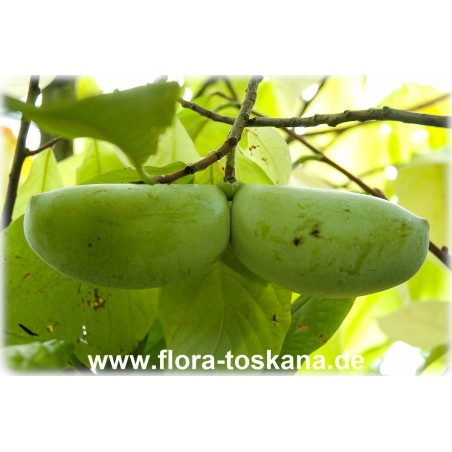Asimina triloba - Pawpaw, American Custard Apple, West Virginia Banana, Indiana Banana
Why not try something new? A frost hardy fruit tree from North America, Indiana Bananas (Paupau, Paw-Paw) bear vitamin rich, tasty fruits that have been little known in Europe so far. A must for all orchard owners with a sense for trends! We offer grafted, self-fertile plants.
For centuries, the Native Americans of North America have appreciated the approximately 300 g, 10 cm long, green-skinned fruit of the Pawpaw, also called Paupau, or Papau (Asimina triloba), that ripen in fall. It is considered the largest fruit native to North America. The yellowish-white flesh melts in the mouth and is very nutritious. It has a refreshing, exotic taste that cannot be compared to any of the Central European fruit but is similar to Custard Apple (Annona). The crowns, which are leafless in winter, tolerate severe frost to below -20°C. The very slowly growing trees (their growth has nothing in common with bananas!) reach a height of 4 to 6 m when planted out (half the size in a pot) and form oval crowns. Its leaves are about 30 cm long, light green, thin and turn golden yellow in fall. The maroon to purple flowers appear mostly before the new shoots in April/May. Since each flower has several ovaries, a pollinated flower can produce several fruits. However, since their own pollen is not always good for pollination, it is better to plant two genetically different plants of a grafted variety. 'Sunflower', however, is a reliably self-fertile variety. In the early years, Pawpaw trees require a partially shaded site. As they grow older, they will tolerate more sun. Since their leaves evaporate a lot of water, the soil should always be kept slightly moist. Due to their slow growth, there is usually no need for pruning. Native to the East of the USA, Pawpaw trees are very hardy plants and very suitable for containers. Pawpaw trees are real newcomers and so far only produced in small numbers.
![]() Varieties:
Varieties:
'Sunflower': Reliably self-fertile variety that provides an annual harvest with only one tree in the garden. Fruit medium in size. Flesh golden yellow, creamy, excellent flavor. Skin thin, greenish-yellow. Fruit shape very variable. Fruits ripen from mid-September.
'Overleese': Fruit large to very large with few seeds. Flesh rich yellow, skin yellow, excellent flavor. Fruit ripening from the beginning of October.
'Davis': Fruit about 12 cm long. Flesh yellow, skin green, good flavor. Seeds very large, easy to remove. Fruits ripen from mid-September. Selected already around 1960 in the USA.
Mango': Large fruits of intensive, sweet taste. Flesh orange-yellow. Variety grows more rapidly than others. Fruits ripen from mid-September.
'Mitchell': Very popular variety for home gardening in the USA. Fruits medium in size. Flesh golden. Flavor excellent. Fruits ripen in early September.
'Pennsylvania Golden': One of the earliest ripening varieties. Ripening possible as early as the beginning of September, depending on weather conditions in summer. New variety from the USA. Fruits very sweet.
'Prolific': Large fruits with yellow flesh and skin and excellent taste. Fruits ripen in late October. Cultivated in about 1980.
'Rebeccas Gold': California cultivar. Fruit medium in size. Flesh very sweet and intensely flavored. Fruits ripen in early October.
'Sweet Alice': Small-growing variety with compact crowns. Fruit large. Flesh orange-yellow. Creamy-sweet, intense flavor. Fruits ripen in early October.
'Taylor': Fruit small. Flesh yellow, skin green, excellent flavor. Fruits ripen in mid-September.
'Taytwo': Fruit medium in size. Flesh yellow, skin greenish-yellow, intense, sweet-creamy taste. Early ripening variety from mid-September. Occasionally spelled Taytoo.
'Wells': Fruits very large. Flesh orange. Magnificent taste has led to a row of awards for this exceptional variety. Fruits ripen in early October.
'Wilson': Fruit medium to small (average fruit weight 90 g) with golden yellow flesh. The number of fruits per tree is higher. Fruits ripen in the course of September. Selected around the year 1985.
Depending on the plant's age, location and nutrient situation, the data may vary significantly.![]() Quality: new fruit tree with high potential for European gardens; very hardy; tasty & large & nutritious fruits
Quality: new fruit tree with high potential for European gardens; very hardy; tasty & large & nutritious fruits
![]() Use: planted in the garden; in pots from March/April to November outside on balcony, terrace and in the garden; all year in an unheated conservatory
Use: planted in the garden; in pots from March/April to November outside on balcony, terrace and in the garden; all year in an unheated conservatory
Data sheet
- Family
- Annonaceae
- Origin
- North America
- Flowering period
- Spring
- Color of flowers
- Red
- Fruits
- Edible fruits
- Growth
- Tree
- Location
- Everywhere
- winter temperature
- Hardy
- Minimum temperature
- -20 °C
- Hardiness Zones
- 6
- Height
- 4 - 5 m
You might also like
Customers who bought this product also bought:


















































